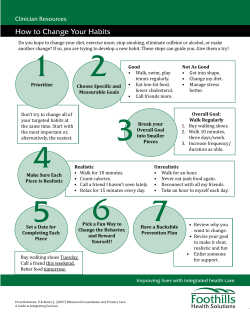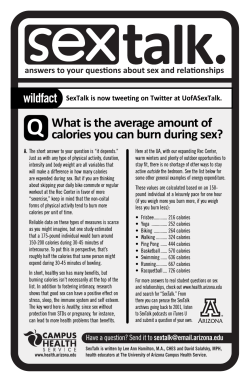
20
20 HEALTH Mental Benefits of Working Out A regular regimen can improve more than just the body ALLY ACKOUREY HEALTH EDITOR For years exercising has been regarded as the number one way to lose weight and keep it off. However, exercise not only has the obvious benefits to the body, but also many other relatively unknown effects that reduce stress and can contribute to overall mental and physical health. Exercise can improve one’s mood and often reduces stress and depression. This is mostly attributed to the release of endorphins, norepinephrine, dopamine, and seratonin which are produced in the brain during long, continuous periods of exercise. All four substances are natural neurotransmitters; endorphins and dopamine are opiates. The stimulation provided by these chemicals can have a relaxing effect that also leaves one feeling happier than before. Hence, the more exercise the body gets, the better a person looks and feels, leading to higher self-esteem and reduced stress and anxiety. Obviously exercising helps manage weight by burning calories, but it can also prevent chronic diseases. According to MayoClinic.com, exercise can contribute to the prevention and management of high blood pressure, as well as increasing “good” cholesterol while lowering the “bad.” Exercise can also strengthen the heart and lungs by delivering oxygen and nutrients to the tissues and causing blood circulation to be more efficient, leaving the body feeling energized. In addition to having more energy to get through a busy schedule and do more things one enjoys, this can prevent heart disease. Why Diets Don’t Work NATALYA SIVASHOV FEATURE EDITOR How To: Get More Exercise It is common knowledge that exercise means burning calories, and that more exercise burns more calories. Exercise not only helps one lose weight but also improves mood. When a person feels better, he or she looks better. Here are a few simple ways to fit some extra physical activity into a busy schedule, with no major lifestyle change: 1. Sure that elevator might be tempting, but taking the stairs is an easy way to burn off a few of those unwanted calories. 2. Grab either a friend or a dog and take a walk. A 20 minute walk every day can make that cookie disappear! 3. Not ready to give up that valuable TV time? Try doing jumping jacks during commercials. 4. Go back to those elementary school days and jump rope outside for as long as possible. Not only will jumping rope burn calories, but getting fresh air will also improve your mood. 5. As if anyone needed another reason to take a trip to the mall, walking briskly around the shopping center for a few hours burns hundreds of calories. 6. As daunting a task as it may seem, washing your own car burns a lot more calories than having someone else do it. Compiled by Ally Ackourey. Study Suggests Diet Soda Linked to Increase in Obesity with one of the mechanisms that help to regulate weight,” said Swithers. According to sciencedaily.com, the use of saccharin A teenage girl inserts a dollar into a vending machine. in place of regular sugar breaks the connection between Pausing before hitting the button to choose her drink, she a sweet sensation and a high-calorie food, thus disrupting ponders, “regular or diet soda?” Finally, she picks the the body’s ability to regulate intake. diet beverage and walks away, pleased with her healthy When a person senses sweet foods, the digestive rechoice. Sound familiar? flexes prepare for the intake of calories. But because the Everyday, milfalse sweetness prolions of Americans vided by the sacchaface this same dirin is not followed by lemma: diet or regthe expected amount ular? of calories, the digesIn an effort tive system becomes to lose a few exconfused. tra pounds, many Over time, the choose to buy the body’s response to diet drink, believsweet foods becomes ing that their deblunted, and as a recision will lead to sult, a person may eat fast and efficient more or expend less weight loss. Afenergy than he or she ter all, they think, normally would. what could be With this new, more effective than shocking explanation this ultimate “0for the rising rates of calorie” beverage? obesity, one might shy However, reaway from diet soft cent studies have drinks for good. suggested that, But no worries for contrary to popthose who drink these ular belief, this low-calorie beverages seemingly benefi- SODA POP: Rachel Borowski ’08 indulges in a diet soda, despite research once in a while—reproving diet beverages may actually cause weight gain. cial product may search at the Universiactually contribute ty of Texas Health Scito obesity. ence Center has reported that only daily or frequent conIn an experiment at Purdue University, Indiana, a sumption can lead to a significant 41% increase in risk of group of rats were fed yogurt sweetened with no-calorie being overweight. saccharin and regular feed, while another group ate yoEven so, people have become more skeptical and alert gurt containing sugar and their regular feed. to the promising advertisements of low-calorie products After a few weeks, the rats that consumed the sugar promoting weight loss. substitute took in more calories and gained more weight Many WHS students express their suspicions about than those that had fed on regular sugar. the beneficial effects of diet soda that companies sport. “If this is the case in rats, there is little reason to think “I don’t believe diet soda is good for you because you that humans don’t have the same response,” said research- can taste the chemicals and sugars in it,” said Lauren Laer Susan Swithers. fountaine ’10. “The artificial ingredients are really bad for Although this theory has not yet been tested on hu- a person, and I think it tastes fake and nasty.” mans, these new findings match the simultaneous rise in And this concern has caused much worry over the isobesity and the increased consumption of diet sodas and sue of which choices are best for one’s health. With new other products containing low-calorie sweeteners. research, many Americans can no longer depend on the In addition, these sugar substitutes may “[interfere] once-thought reliable diet soda to control their weight. TIFFANY LOH FEATURE EDITOR PHOTO BY ALLY ACKOUREY Teenagers and adults often turn to fad diets to lose about five to ten pounds in the first few weeks, eliminating all of the calorie supply and most of their energy source, which increases appetite and causes immune difficulties. As soon as old eating habits return, weight is gained more quickly and it is possible to actually gain more weight than was lost. Because people often come together to eat at social gatherings such as restaurants and religious dinners, one may develop a sense of alienation from close family and friends or simply ‘non dieters,’ as well as an unhappy relationship with dietary foods. Eventually cravings become unstoppable, and most dieters start cheating on their diets by consuming the ‘Forbidden Foods.’ While the cheats are small, one may still continue to lose some weight, though it will take longer as the immune system weakens and the cravings increase. No exercise while on a diet can cause the loss of lean muscle mass, water and essential fats. Lost muscle slows down metabolism and prolongs the diet as the body burns fewer calories per day just to keep the body functioning. Since the metabolism (energy) is slowed it takes a conscious effort to exercise while dieting. Also, losing weight at a very rapid rate may increase the risk for developing gallstones (clusters of solid material in the gallbladder). Daily exercise improves appearance and health altogether. Clients of Bariatric (fat removal) surgery clinics are prescribed an hour of exercise a day before they can undergo surgery. Some lose large amount of weight and decide to skip the surgery after all. Research suggests that losing one half to two pounds each week by eating moderate portions, and exercising daily is the best way to lose weight and keep it off. A reduced-calorie eating plan that includes carbohydrate, protein, and fat will also allow you to lose weight without missing out on the key nutrients, such as: whole grains, fruits, and vegetables. Eating fewer than 130 grams of carbohydrates a day can lead to the buildup of Ketones (partially broken-down fats) in the blood, which is a risk factor for gout (a swelling of the joints) and kidney stones because of the production of uric acid. Many diets use natural ingredients and herbal products that are as natural food supplements, yet these products are mostly not scientifically tested to prove safety. For example, herbal products containing ephedrine have caused serious health problems and even death. When dieting to look better on a TV show, they may be an appropriate solution, but if the plan is to lose twenty pounds or more, you are better off eliminating foods step by step and still consuming enough to gain muscle. According to the American Heart Association, 73,000,000 Americans live with heart disease. That exercise can prevent one less American from suffering a very life threatening condition should be motivation enough to attempt to get at least a little more exercise every day. Another motivating benefit of daily exercise is that it can promote better sleep, which, from experience, is a very important aspect of any high school student’s – or anyone’s, for that matter – life and well-being. It can help a person fall asleep faster and sleep deeper, improving concentration, productivity, and mood. Since results are best seen after exercising in the afternoon, no significant change is necessary in a student’s busy lifestyle since the majority of classes end before three pm. Just think – a little sweat can help bring not only refreshing sleep, but also acts as a natural stimulant to the brain, providing motivation to work harder and apply oneself to everyday tasks. So how much is enough? According to the American Heart Association and the American College of Sports Medicine, healthy individuals under 65 years of age should get at least 30 minutes of moderate-intensity aerobic activity five days a week, or at least 20 minutes of highintensity aerobic activity three days a week. Examples of moderate-intensity activities include brisk walking and swimming, while exercises like running and bicycling is considered high-intensity. So whether one chooses to go on a run a few times a week, or to swim every day, he or she is bound to reap from the multitude of benefits exercise provides, both physically and mentally. March 20, 2008 • THE ARROW
© Copyright 2025





















